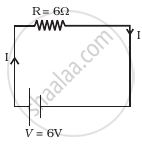Advertisements
Advertisements
प्रश्न
The relaxation time τ is nearly independent of applied E field whereas it changes significantly with temperature T. First fact is (in part) responsible for Ohm’s law whereas the second fact leads to variation of ρ with temperature. Elaborate why?
उत्तर
Relaxation time is bound to depend on velocities of electrons and ions. Applied electric field affects the velocities of electrons by speeds at the order of 1 mm/s, an insignificant effect. Change in T, on the other hand, affects velocities at the order of 102 m/s. This can affect τ significantly.
[ρ = ρ(E, T) in which E dependence is ignorable for ordinary applied voltages.]
APPEARS IN
संबंधित प्रश्न
Derive an expression for drift velocity of free electrons.
Write its (‘mobility’ of charge carriers) S.I. unit
How does drift velocity of electrons in a metallic conductor vary with increase in temperature? Explain.
On the basis of electron drift, derive an expression for resistivity of a conductor in terms of number density of free electrons and relaxation time. On what factors does resistivity of a conductor depend?
Why alloys like constantan and manganin are used for making standard resistors?
Define relaxation time of the free electrons drifting in a conductor. How is it related to the drift velocity of free electrons? Use this relation to deduce the expression for the electrical resistivity of the material.
The position-time relation of a particle moving along the x-axis is given by x = a - bt + ct2 where a, band c are positive numbers. The velocity-time graph of the particle is ______.
An electric bulb.is rated 220 v and 100 watt power consumed by it when operated on 'no volt is:-
The drift velocity of a free electron inside a conductor is ______
- Consider circuit in figure. How much energy is absorbed by electrons from the initial state of no current (ignore thermal motion) to the state of drift velocity?
- Electrons give up energy at the rate of RI2 per second to the thermal energy. What time scale would one associate with energy in problem (a)? n = no of electron/volume = 1029/m3, length of circuit = 10 cm, cross-section = A = (1mm)2

